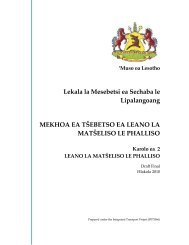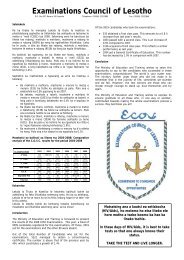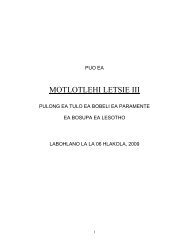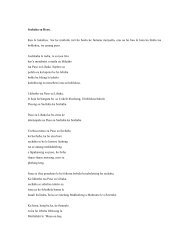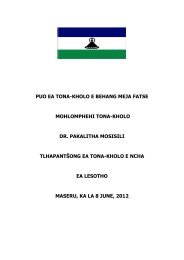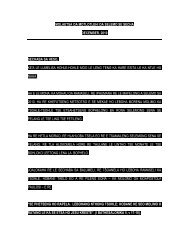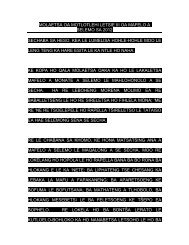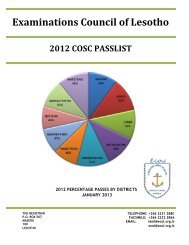PM's Inaugural Speech-08 June 2012 - The Lesotho Government ...
PM's Inaugural Speech-08 June 2012 - The Lesotho Government ...
PM's Inaugural Speech-08 June 2012 - The Lesotho Government ...
You also want an ePaper? Increase the reach of your titles
YUMPU automatically turns print PDFs into web optimized ePapers that Google loves.
PUO EA MOHLOMPHEHI TONA-KHOLO<br />
MONGHALI MOTSOAHAE THOMAS THABANE<br />
TLHAPANTŠONG EA HAE E LE TONA-KHOLO<br />
EA LESOTHO<br />
MASERU, KA LA 8 JUNE, <strong>2012</strong>
MOTLOTLEHI KHOSI LETSIE LA BORARO LE MOTLOTLEHI<br />
MOFUMAHALI ‘MASENATE<br />
YOUR EXCELLENCIES HEADS OF STATE AND GOVERNMENT<br />
MOHLOMPHEHI MOOKAMELI OA SENATE<br />
MOHLOMPHEHI MOTSAMAISI OA LIPUISANO KA LEKHOTLENG<br />
LA SECHABA<br />
MOHLOMPHEHI MOOKAMELI OA LEKHOTLA LA MAIPILETSO<br />
MOHLOMPHEHI MOAHLOLI E MOHOLO<br />
BAHLOMPHEHI BAAHLOLI BA LEKHOTLA LE PHAHAMENG<br />
BAHLOMPHEHI LITHO TSA LEKHOTLA LA NAHA<br />
YOUR EXCELLENCIES HEADS OF DIPLOMATIC MISSION AND<br />
HEADS OF INTERNATIONAL ORGANIZATIONS<br />
MOHLOMPHEHI RAMOLAO E MOHOLO OA ‘MUSO<br />
BAHLOMPHEHI BAKHETHOA BA SECHABA<br />
MARENA A SEHLOOHO, LE MARENA ‘OHLE A TŠOARISANENG<br />
PUSO LE ‘ONA<br />
BALULA-SETULO LE LITHO TSA KOMISI EA KHIRO EA<br />
BAHLANKA BA SECHABA, KOMISI EA KHIRO EA LITICHERE,<br />
KOMISI E IKEMETSENG EA LIKHETHO, KOMISI EA PUSO EA<br />
LIBAKA LE KOMISI AIDS<br />
MONGOLI E MOHOLO OA’MUSO<br />
MONAMOLI<br />
2
LEKHOTLA LA LIKEREKE LESOTHO<br />
BAETA-PELE BA MEKHA EA LIPOLOTIKI<br />
BANGOLI BA BAHOLO BA MAKALA A ’MUSO<br />
BAOKAMELI BA SESOLE, SEPOLESA, MAUTLOELA LE LITSI TSA<br />
TLHABOLLO EA BATŠOARUOA<br />
BAPHATLALATSI BA LITABA<br />
BAHLANKA BOHLE BA SECHABA<br />
BO-NTATE LE BO-‘M’E LE LONA BACHA<br />
Baheso, lea elelloa hore kahare ho rona ho na le baeti ba sa<br />
bueng puo ena ea rona. Ka hona ntumelleng ke mpe ke ba<br />
hlalosetse hore ke tla bea puo ea ka ka leleme la Sesotho,<br />
empa khabareng le bona ke tla ba kumela hore na ke ne ke<br />
ntse ke reng ho lona sechaba sa heso.<br />
At the outset, permit me to make my statement in Sesotho, our<br />
mother tongue, so that I can be clearly understood by the<br />
Basotho Nation. At the end, I will convey my message in<br />
English, which is the second official language of the Kingdom of<br />
<strong>Lesotho</strong>.<br />
3
Sechaba sa heso,<br />
Ke ema ka pele ho lona ke aparetsoe ke thabo e<br />
khaphatsehang, le boikokobetso bo boholo, ho amohela<br />
boikarabello bona boo ke bo tšepeloang ke Motlotlehi le<br />
Sechaba sa Basotho ho ba hlooho ea ‘Muso oa Motlotlehi.<br />
Re tsoa likhethong tse akaretsang haufinyane, tseo hantle li<br />
hlōtsoeng ke lona sechaba sa heso, kaha e le lona, ka bongata<br />
ba lona, banna le basali ba heso, le lona bacha, le tlisitseng<br />
boemo bona ka khetho ea lona. Ka lebaka lena, tlholo ena ha<br />
se ea ka, ke ea lona.<br />
Letsatsing lena la mathomo, leo ka lona ke nkang kano ea ka<br />
ea bohlanka, ke ema ka pele ho lona sechaba sa heso, ho le<br />
tiisetsa hore, ka thuso le matla a Morena Molimo, ke tla etsa<br />
sohle se matleng a ka, ho le sebeletsa ka ‘nete, ka toka, le ka<br />
botšepehi, le ho le baballela puso e hloekileng e nang le<br />
ponaletso, phethahatsong ea merero le litakatso tsa lona<br />
sechaba sa Basotho.<br />
Letsatsi lena la kajeno, ke letsatsi le hloliloeng ke Morena<br />
Molimo. Ke ka thato ea Molimo ea matla ‘ohle re tsebileng ho<br />
4
tataea har'a lefifi le letšo la likhohlano le liphapang tsa<br />
lipolotiki, ho fihlela mona moo re leng teng kajeno. Hape ke ka<br />
matla a Molimo, ‘Mopi le Morena oa rona, re tlang ho qala<br />
leeto lena le lelelele, leeto le metheo le meepa, la puso ka<br />
lilemo tse hlano tse tlang.<br />
Ntumelleng hee, sechaba sa heso, ke qale pele ka ho leboha<br />
eena Morena Molimo, le ho mo kopa ho re bonesetsa kamehla,<br />
hore re bone tsela ea rona leetong lena leo re le simollang<br />
‘moho kajeno.<br />
Motlotlehi Letsie III<br />
Motlotlehi ‘M’e ‘Masenate<br />
Bahlomphehi<br />
Bo-Ntate le bo-‘M’e,<br />
Lebitsong la ka le lebitsong la lona sechaba sa heso, ke leboha<br />
ka pelo eohle ea ka baeti ba rona ba bohlokoa ba tsoang<br />
linaheng tse nang le setsoalle le naha ea rona, baemeli ba<br />
mekhatlo ka ho fapakana ha eona le metsoalle ea rona eohle, e<br />
tsoang kantle le kahare ho naha. Re re ho lona, re leboha ruri<br />
ha le tsebile ho behella ka thoko mesebetsi ea lona ho tla<br />
5
tlotlisa letsatsi lena, le ho tla ba lipaki tsa kano ea bohlanka eo<br />
ke sa tsoa e nka, ha ke amohela thómo ea sechaba.<br />
Bahlomphehi ba ka,<br />
Ka ho khetholoha ke lakatsa ho lebohela Motlotlehi, ‘Muso oa<br />
hae, esita le sechaba sa Basotho ka kakaretso, ka mosebetsi o<br />
moholo oo re tsoang ho feta ho oona oa likhetho, ‘me o<br />
entsoeng ka makhethe a maholo ruri.<br />
Ke boele ke lebohe ka pelo eohle ea ka mekhahlelo ena e<br />
latelang:<br />
Metsoalle ea <strong>Lesotho</strong> le Bafani, ka litlatsetso le lithuso<br />
tseo ba li entseng ho re tšehetsa mosebetsing ona o<br />
boima oa likhetho;<br />
Baetapele lipolotiking tsa naha ena, bao esaleng re<br />
tšoarana ka matsoho tokisetsong ea likhetho tsena. Re<br />
leboha haholo khotso eo re sebelitseng ka eona;<br />
Baruti ba Moshoeshoe, ka lithapelo le likhothatso, le ka<br />
ho kenya letsoho ka mokhoa o matla ho bopa moea oa<br />
6
kutloano le mamellano, hore re behe naha ea rona pele<br />
ho litakatso tsa rona ka linako tsohle. Re le Basotho re<br />
lokela ho ikotla sefuba ka tlatsetso e matla e etsoang ke<br />
boetapele ba likereke, e seng feela litabeng tsa moea,<br />
empa le tharollong ea mathata a puso ea sechaba ka<br />
kakaretso;<br />
Re leboha mekhatlo e ikemetseng, ka tlatsetso eo e e<br />
entseng, haholo-holo thupelong ea bakhethi le ho<br />
hlokomelisa sechaba ka bohlokoa ba ngoliso le likhetho<br />
ka bo-tsona;<br />
Balebelli ba likhetho bohle, ba <strong>Lesotho</strong> esita le ba<br />
tsoang linaheng le mekhatlong e fapakaneng ea lefatše.<br />
Re ananela bolula-qhooa le qeto ea bona hore likhetho<br />
e bile tsa khotso le bolokolohi, ‘me tse nang le<br />
ponaletso;<br />
Komisi e Ikemetseng ea Likhetho (IEC) le bahlanka<br />
bohle ba eona, ka tšebetso e ntle tlhophisetsong le<br />
tsamaisong ea likhetho tsena. Rea leboha ruri, ‘me le<br />
7
moo e bang mefokolo e bile teng, re se re ba inetse<br />
matsoho metsing hoba matsoho ho lutla a sebetsang;<br />
Re leboha le ho thoholetsa marena a naha ena ka<br />
kakaretso, ka tlatsetso ea bona tokisetsong le<br />
tsamaisong ea mosebetsi ona oa likhetho;<br />
Bahlanka ba tšireletso ka mafapha ’ohle a bona, ka<br />
mosebetsi o khahlehang oo ba o entseng tokisetsong ea<br />
likhetho le tšireletsong ea sechaba le thepa, le ho lula e<br />
le bo-‘mesa-mohloane ho bona hore likhetho tsena e ba<br />
tsa khotso;<br />
Baphatlalatsi ka mafapha ’ohle a bona, kamoo ba ileng<br />
ba bea sechaba sehlohlolong sa litaba ka linako tsohle;<br />
le<br />
Sechaba sa Basotho ka kakaretso, ka mamellano,<br />
tlhomphano le khotso, tseo ka tsona ba sebelitseng<br />
mosebetsi ona o moholo oa likhetho.<br />
8
Ka thabo e kholo, ‘me ka ho khetholoha, lebitsong la bo mphato<br />
oa ka, baetapele ba mekha le makhotla a lipolotiki, ke leboha<br />
balekane ba rona le malapa a rona, ka tšehetso eo esaleng ba<br />
re fa eona haesale re qala mosebetsi ona o boima oa likhetho.<br />
Ho tloha qalong ho fihlela qetellong, joko ena e boima re ne re<br />
e jarisane le bona. Ba oele, ba tsoha le rona, ba re khothatsa<br />
ha eka re felloa ke matla.<br />
Sechaba sa Heso<br />
Bo-Ntate le Bo-‘M’e<br />
Le lona bacha,<br />
Lerōle le neng le aparetse makhotla le mekha ea lipolotiki<br />
matsatsing a ho feta, ha ho ne ho iketeloa botšehetsi ba<br />
sechaba, le kokobetse joale. Sefefo se matla sa lerata la<br />
lipolotiki tsa likhetho se khutsitse. Sechaba se hoile ka lentsoe<br />
le phefa, se entse khetho ea sona. Ha sechaba se buile, eba le<br />
lumme.<br />
Re le Basotho, re lehlohonolo hobane re sechaba se thehiloeng<br />
ke Morena Moshoeshoe I, ea ileng a kopanya mefuta-futa ea<br />
lichaba, a re tlamahanya hammoho, ra ba ngatana-‘ngo’e e<br />
bitsoang Basotho le kajeno. Ha lichaba tse ling li aroha’ngoa ke<br />
9
lipuo le litumelo tse fapakaneng, liphapano tsa merabe,<br />
mekhoa le meetlo, rona Basotho re sechaba se le seng se<br />
buang puo e le ‘ngoe. Ka hona, ho fapana ha rona ka maikutlo<br />
le mapetjo a lipolotiki ha hoa lokela ho ba sesosa sa karohano<br />
ea rona.<br />
Morena Moshoeshoe o ile a theha sechaba sa Basotho nakong<br />
eo lichaba li neng li futuhelana ebile ho e-na le ba jang ba<br />
bang, e leng malimo, a qetelletseng a jele ntata’e moholo.<br />
Empa Morena Moshoeshoe o ile a atleha ho fa lira tsa hae<br />
khotso, esita le ‘ona malimo ao. A li fa mofuthu oa lerato, a li<br />
tiisetsa tšireletso, a bokella marena le lichabana tsa ‘ona, a ba<br />
tlamahanya ‘moho, ‘me a ahela lesaka taelo ea morena<br />
Mohlomi ha a ne a re, ho se be motho ea ntseng a re ho<br />
Moroa, Moroa tooe. Ke mona kajeno re sechaba har’a lichaba<br />
tse ling, re sechaba se tsebahalang ka khotso, ‘me re<br />
itsamaisetsa litaba tsa puso ea rona. Re tseba ho qothisana<br />
lehlokoa lipolotiking ho se ea thibeloang ka lebaka la maemo a<br />
hae, tumelo ea hae, kapa ka hore na o tsoa sebakeng se fe.<br />
Haele mona sefefo se khutsitse, ‘me sechaba se supile tsela, ke<br />
itlama kapele ho Morena Molimo, kapele ho Motlotlehi, kapele<br />
ho Likereke tsa rona, marena a rona, makhotla le mekha ea<br />
10
lipolotiki le balateli ba ‘ona, le ho sechaba ka kakaretso, bohle<br />
ba teng le ba sieo koano, hore ke tla sebeletsa sechaba sohle<br />
sa Basotho ka toka, ka ‘nete le bohloeki. ‘Muso o eteletsoeng<br />
pele ke ‘na, ha e na ho ba ‘muso oa mokha oa heso oa<br />
lipolotiki, kapa oa bao re leng setlamong le bona feela, empa e<br />
tla ba ‘muso oa sechaba sa Basotho ka moka. Ke tla sebeletsa<br />
ho kopanya Basotho e le hore re tle re tsebe ho hlola mathata a<br />
bofuma, mathata a tlhokahalo ea mesebetsi le mathata a tlala<br />
le mafu ana a hlorisang sechaba sa habo rona.<br />
Ke mema bo-mphato oa ka, lona bao re khethiloeng le lona,<br />
hore re tšoaraneng ka matsoho, ‘me re beheng mohoma<br />
temeng. Mona ke bua ka bakhethoa kaofela ke sa khetholle.<br />
Sechaba se re tšepetse ho se etella pele ka sebopeho sena seo<br />
re emeng ka sona. Ka hona re sepane sa sechaba, re sepane se<br />
le seng. Ka mantsoe a mang, sechaba se re hlomphile haholo<br />
ho re fa boikarabello bona ba ho se etella pele. Qholotso e re<br />
tobileng ke hore re tiisetse sechaba hore ha sea khetha ka<br />
phoso, ehlile se betsitse chitja, ‘me e le sechaba, lentsoe la<br />
sona ke lentsoe la Molimo.<br />
11
Sechaba sa Heso,<br />
Ha ke hloke ho le hopotsa nalane ea lipolotiki tsa naha ena ea<br />
rona. Le lipaki hore re fetile nakong tse thata ho tloha lilemong<br />
tsa bo-1970, 1974, 1994, le bo-1998. Re sebelitse ka thata<br />
hore re fihle boemong bona ba puso ea sechaba ka sechaba,<br />
boo re leng ho bona kajeno.<br />
Re lokela ke hona ho hetla morao, ’me re nene lintho tsohle tse<br />
re hlokisitseng botsitso ka nako e fitileng, e le hore re phetleng<br />
leqephe le lecha nalaneng ea puso ea naha ea rona, re<br />
matlafatse kopano le bo-'ngoe ba sechaba tse re li rutiloeng ke<br />
Morena Moshoeshoe I, re bouleleng khotso le botsitso ba<br />
<strong>Lesotho</strong>, ‘me re aheng naha ena molemong oa rona le<br />
molemong oa meloko e tlang.<br />
Sechaba sa Heso,<br />
Haele mona re kena leetong lena la puso ea lilemo tse hlano tse<br />
tlang, ke rata hore re ikhopotseng hore ka selemo sa 2000<br />
sechaba sa <strong>Lesotho</strong> se ile sa lumellana ka tokomane e bitsoang<br />
Vision 2020. Tokomane ena e supa lintlha-kholo tsa hore na re<br />
labalabela hore <strong>Lesotho</strong> le be maemong a fe a ntlafatso. Litaba<br />
tseo kaofela li lokela ho arabeloa ka meralo e hlakileng ea<br />
12
‘muso le Moralo oa Ntlafatso oa Naha (National Strategic<br />
Development Plan).<br />
Phephetso e kholohali ka ho fetisisa, eo re tobaneng le eona, ke<br />
pheliso ea bofuma le ntlafatso ea maphelo a Sechaba naheng<br />
ea rona. E le ho fihlela sepheo sena, ‘muso oa Motlotlehi o<br />
lokela ho tsepamisa maikutlo a oona holim’a kholiso ea moruo,<br />
ka sebopeho seo mafapha ‘ohle a tlang ho kenya letsoho le ho<br />
khola litholoana tsa katleho. ‘Nete ke hore, ha moruo o hola le<br />
mesebetsi e tla ata:<br />
Re tla ema ka maoto ke hona, ho hohela le ho thusa bo-<br />
ramatsete ba tsoang kantle le kahare ho naha ho theha<br />
mesebetsi mona <strong>Lesotho</strong>;<br />
Re tla ntlafatsa khokahanyo le marang-rang a litšebeletso<br />
tse kang litsela, metsi, motlakase, le meaho e hlokahalang<br />
bakeng sa khoebo le khoebisano;<br />
13
Re tla bulela mafapha ‘ohle ho kenya letsoho ka matla<br />
litabeng tsa ntlafatso ea naha; ho kenyeletsa basali ka<br />
mekhatlo ea bona, bacha ka Lekhotla la bona (National<br />
Youth Council), esita le mekhatlo e ikemetseng.<br />
Re tla loantša ka matla litlolo tsa molao naheng ena ea<br />
rona haholo-holo bosholu, bobolu le tlhekefetso ea<br />
maqeku, basali le bana;<br />
Re tla hlompha boikemelo ba litšia tse tharo tsa puso e<br />
leng Makhotla a Boahloli (Judiciary), Lekhotla la Ketsa<br />
Melao (Paramente) le Lefapha la Bophethahatsi<br />
(Executive);<br />
Re tla ntlafatsa thuto, haholo ea mahlale le ea matsoho<br />
hore e re tsoalle mesebetsi;<br />
Re tla kenya tšebetsong meralo e ka tsebang ho arabela<br />
phephetso ea maemo a leholimo a fetohileng haholo<br />
morao tjena, e le ka morero oa ho ntlafatsa tlhahiso ea lijo<br />
le ho ntlafatsa mehlape;<br />
14
Re tla ntšetsa pele toantšo ea tšoaetso ea lefu la HIV le<br />
AIDS, ‘me re tla etsa kahohle ho fumana mekhoa ea ho<br />
fokotsa sekhahla sa mafu a bo-‘m’e le masea nakong ea<br />
pelehi (Child and Maternal Deaths);<br />
Re tla tšireletsa maqheku, likhutsana, le ba nang le<br />
bokooa, le bohle ba tlokotsing e le ho ba bebofaletsa<br />
mathata a bophelo.<br />
Empa ka holimo ho tsohle, re lokela ho ba seli ho baballa<br />
litokelo tsa mantlha tsa botho le ho tebisa metso ea puso ea<br />
sechaba ka sechaba, khotso le botsitso, hobane kantle ho tsona<br />
ha ho letho leo re ka le fihlelang ka katleho.<br />
Your Majesties<br />
Excellencies<br />
Distinguished Guests,<br />
It is with a deep sense of honour and humility that I stand<br />
before you to accept the responsibility of the high office of<br />
Prime Minister and Head of His Majesty’s <strong>Government</strong>. At the<br />
very beginning of this five year constitutional term of the new<br />
government, I pledge to execute the onerous responsibilities of<br />
this high office with honesty, transparency and dedication. In<br />
15
executing this sacrosanct mandate as Prime Minister of<br />
<strong>Lesotho</strong>, the wishes and aspirations of my people will always<br />
take precedence over my own.<br />
On behalf of the government and people of <strong>Lesotho</strong>, and<br />
indeed, on my own behalf, I wish to express our profound<br />
gratitude to all of you, my country men and our guests from<br />
other countries, for having made time to grace this occasion<br />
with your presence.<br />
We are deeply indebted to our development partners,<br />
International organizations, non-governmental organizations,<br />
the Christian Council of <strong>Lesotho</strong>, our security agencies and the<br />
media for the valuable contribution which they made in various<br />
ways to facilitate successful holding of the general election that<br />
we have just gone through.<br />
I wish to single out for special commendation, the Independent<br />
Electoral Commission and its staff, for their dedication and the<br />
exemplary manner in which they applied themselves in the<br />
preparations preceding the elections and during the conduct of<br />
the election itself.<br />
It would be remiss of me not to pay a deserving tribute to the<br />
entire nation of Basotho, for the patience and maturity with<br />
which they went through the elections.<br />
16
Your Majesties<br />
Excellencies<br />
Distinguished guests,<br />
We have had elections that have been declared by the local and<br />
International observers as free, fair and transparent. We are<br />
not unaware of the elaborate and hard work that has been<br />
done by the Election Observers over the past days and weeks.<br />
For that we are indeed grateful.<br />
<strong>The</strong> election that we have just gone through is a powerful voice<br />
through which the people of <strong>Lesotho</strong> have elected a<br />
government of their choice. Today’s occasion is, therefore, a<br />
reflection of the will of the people of <strong>Lesotho</strong>. <strong>The</strong><br />
electioneering time is now behind us. <strong>The</strong> dust of the election<br />
campaigns must now settle. <strong>The</strong> people have spoken through<br />
the ballot box. It is now time for us to put shoulder to the<br />
wheel and join hands to develop our beloved country for the<br />
betterment of every Mosotho man, woman and child in our<br />
towns and villages.<br />
<strong>The</strong> real winner of this election is no other than the people of<br />
<strong>Lesotho</strong> themselves. <strong>The</strong>ir will takes precedence over our<br />
personal wishes. Let us get on with the business of governing<br />
and of developing our country for the benefit of our people and<br />
the future generations.<br />
17
On this occasion, I extend an invitation to all political leaders in<br />
<strong>Lesotho</strong> and the nation as a whole, to put aside political<br />
differences that were manifested in the heat of the election<br />
campaigns, and to join hands to respond to the challenges that<br />
face us as a nation.<br />
We, the people of <strong>Lesotho</strong>, are fortunate that we are a<br />
homogeneous nation that speaks one language, that practises a<br />
common culture and that is united by kinship. We are<br />
untouched by the sentiments of tribalism or religious schisms.<br />
It would be folly to allow ourselves to be divided by the<br />
differences of our political opinions.<br />
As we start this long journey of governance over the coming<br />
five years, I stand before God, His Majesty, church leaders,<br />
chiefs, leaders and followers of political parties, and the nation<br />
as a whole, to pledge my commitment to serve this nation<br />
faithfully, with dedication and transparency. I will endeavour to<br />
undertake the widest consultations on issues of importance to<br />
the nation while at the same time doing all in my power to<br />
eradicate the scourge of corruption in the conduct of public<br />
affairs.<br />
18
Your Excellencies<br />
Distinguished guests,<br />
I need not remind anyone that over the past half century since<br />
<strong>Lesotho</strong> attained political independence, our country has gone<br />
through successive periods of turbulence and agony in the<br />
political sphere. Our people have worked very hard to have<br />
the rule of law, peace and stability that we enjoy today. We<br />
must build on the achievements that we have already made to<br />
further consolidate peace and stability in our country and to<br />
deepen the roots of democracy and good governance.<br />
Our elections in 2002 ushered in a new era of political<br />
accommodation and inclusiveness, which was embodied in the<br />
new electoral model that we adopted. That model contributed<br />
significantly to the advancement of peace and stability in<br />
<strong>Lesotho</strong>. We have continued to improve on that model and to<br />
remove some of its shortcomings. <strong>The</strong> current electoral<br />
legislation has, once again, modified and improved in various<br />
ways on the electoral model that we use in <strong>Lesotho</strong>. It has, in<br />
particular, also introduced a system that guarantees increased<br />
representation of women in parliament.<br />
Through our collective effort we have succeeded in taking our<br />
country to higher level of political maturity. In effect, we have<br />
transformed the nature of politics in our country. We must<br />
build on this success to transform our country’s economic<br />
situation. <strong>The</strong> challenges that confront us as a nation today<br />
are many and varied. While we may define them in different<br />
19
political dialects, in reality, the challenges that confront us as<br />
we begin the 8 th Parliament of His Majesty’s government, are<br />
the same and common to all of us. <strong>The</strong>y include;<br />
Poverty eradication, shared economic growth and<br />
employment creation;<br />
Building of effective governance institutions in the public<br />
and private sectors;<br />
Infrastructure development for facilitation of trade and<br />
access to services;<br />
Investment in the education of our people and<br />
transformation of skills development, particularly among<br />
youth and women;<br />
Increasing access to improved health facilities in order to<br />
reduce maternal and child mortality, as well as<br />
vulnerability to pandemics such as HIV and AIDS;<br />
Improvement of agriculture, food security and<br />
preparedness for natural disasters, particularly in the wake<br />
of the consequences of climate change;<br />
Combating of environmental degradation;<br />
20
Increasing the access of women and youth to resources in<br />
order to facilitate their involvement in development<br />
activities;<br />
Effective and efficient dispensation of justice,<br />
Escalation of the fight against corruption, all forms of<br />
crime, including violent crime, robberies, and stock theft;<br />
and<br />
Provision of efficient delivery of public services.<br />
In addressing these challenges, the consolidation of peace and<br />
deepening of the roots of democracy and good governance<br />
must remain our top priority because without peace and good<br />
governance, there can be no development.<br />
Mohlomphehi Motsamaisi oa tšebeletso,<br />
Ke lakatsa ho qetella puo ea ka ka ho mema Basotho bohle, ka<br />
bo-mong le ka lihlopha tsohle tsa bona, hore joaloka ha<br />
mothehi oa sechaba sa rona Morena Moshoeshoe oa Pele, a re<br />
rutile, re beng ngatana-‘ngoe, re tšoaraneng ka matsoho joalo<br />
ka bana ba thari ho pholosa naha ea rona litleneng tsa bofuma<br />
le ho hloka botsitso. Re ke re beng le sepheo se le seng, e leng<br />
ho fumanela naha ea rona kholiso ea moruo, tsoelopele le<br />
boiketlo ba sechaba.<br />
21
Molimo a ke a boloke Batlotlehi, Molimo a ke a boloke <strong>Lesotho</strong><br />
le Basotho.<br />
Khotso, Pula Nala.<br />
22




